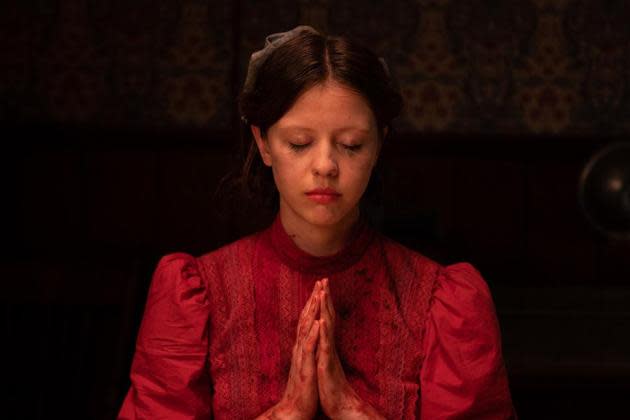Venice Review: Mia Goth In Ti West’s ‘Pearl’
- Oops!Something went wrong.Please try again later.
- Oops!Something went wrong.Please try again later.

What’s the matter with Pearl? Plenty, as it turns out in Ti West’s terrifically enjoyable postscript to his spring release X, which saw a 1970s film crew fall brutally afoul of an elderly farmer and his wife while shooting a porno in their barn. Unusually for a horror film, X had the same actress — Mia Goth — as both the final kill (the farmer’s psychotic wife Pearl) and the final girl (sex-film starlet Maxine), and this intelligent, not to mention almost indecently hasty prequel explains the reasons.
Pearl, screening out of competition at the Venice Film Festival, is that rare horror franchise follow-up that, while mindful of expectations from its predecessor’s core gore audience, has considered artful new ways to drill down into the essence of the original.
More from Deadline
First, a quick digression into the appeal of X and Ti West’s films in general: West has an almost forensic handle on what a period genre movie should look like — a talent showcased very blatantly in 2009’s lurid video-nasty pastiche House of the Devil, and more subtly in 2013’s naturalistic Jim Jones chiller The Sacrament. But West also updates as he reflects, and X does a very effective job of reminding us that the 1970s were a time of schism: in that first wave of splatter films, killers were often prudish, sexless and resentful of the permissive younger generation — a hang-up that was actually more representative of the conservative film industry of the time than real life. The swinging stars of X meet their match, however, in the sexually rapacious Pearl, a darkly playful subversion of the vengeful uptight-old-lady stereotype established by Psycho.
Pearl, then, is an origins story, which explains, with a darkly funny inevitability, how a naive soldier’s wife with Hollywood in her sights tried to get away from a cloying life on her family’s farm only to end up back there. It starts in 1918, in the thick of the Spanish flu pandemic, but the style is 1930s Depression-era escapism, as Pearl dreams of life as a silver-screen dancing girl while stuck at home with her strict German mother (Tandi Wright) and a paralyzed father (Matthew Sunderland) who views events with a frozen terror worthy of Emile Zola’s Thérèse Raquin (or Park Chan-wook’s Thirst, for a more recent reference).
Pearl sings and dances for the farm animals, named Charlie and Mary after her favorite United Artist silent-movie stars, and on a trip into town to buy morphine for her father she sneaks off to a cinema where an encounter with its suave projectionist (David Corenswet) opens up the possibility of a new bohemian lifestyle.
These scenes reveal interesting parallels with X: the projectionist shows Pearl explicit stag films from France, and for a while it seems Pearl might go off on the same journey that the naïve Maxine went on in X, pursuing her sexual liberty in Europe. Clearly, and it’s no spoiler to say so, that cannot happen, since she’s not going anywhere as we know from the setup.
Nevertheless, West’s film continues to spotlight Pearl’s obsession with movie stardom at the same time as it shows the impossibility of it ever happening (the seemingly random alligator from X is brought back to emphasize this at crucial, juicy moments), but the clincher is a fantastically heightened tantrum that reaches a crescendo when Pearl screams at her mother, “You don’t know what I’m capable of!” She does, though, and that might actually be the creepiest scene in the whole movie.
There really aren’t a huge amount of comparisons for Pearl, since this is usually the stuff of flashback or subtext, but the notion of insanity and thwarted lives does tap into an interesting subgenre, notably the slew of “hagsploitation” films that followed Whatever Happened to Baby Jane? in 1962.
Pearl’s dancing ambitions also come with a heady whiff of What’s the Matter with Helen? (1971), a camp 1930s-set whodunit starring Debbie Reynolds and Shelley Winters. That film was directed by Curtis Harrington, an anomaly in Hollywood whose terrific career memoir, Nice Guys Don’t Work in Hollywood, name-checks Kenneth Anger, Roger Corman and The Colbys — a reminder that such an arthouse/grand guignol crossover isn’t anything new, just as Pearl reminds us that porn has been around since the invention of the camera. Indeed, film history is always up there on the screen, in the seductive Douglas Sirk-ian colors, in the lush, sincere Max Steiner-esque score, and in the edit with the old-school use of wipes and iris-outs.
But to make all this work Pearl needs a star, and it has it in Goth, whose powerhouse performance elevates what could so easily be a cartoon villain.
It’s hard to explain just how she does it, but what starts as a golly-gee channeling of The Wizard of Oz’s Dorothy comes slowly unraveled, culminating in a harrowing confession to Pearl’s absent husband that we see in spellbinding, one-take closeup. It will be interesting to see where Pearl takes her next; in the meantime, this might be the most committed female performance in a horror-comedy since Kathleen Turner in Serial Mom, but one given permission to go much, much deeper emotionally in the Far From Heaven of slashers.
Best of Deadline
Sign up for Deadline's Newsletter. For the latest news, follow us on Facebook, Twitter, and Instagram.

